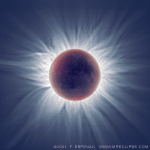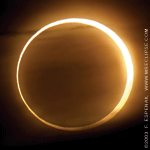Welcome to the STEREO Learning Center
All About Eclipses
The Moon, Earth's only natural satellite, orbits the Earth every 29.5 days. New Moon occurs
when the Moon passes between Earth and the Sun. A solar eclipse is possible only at New Moon when,
during its monthly revolution around the Earth, the Moon happens to exactly line up bewtween the Earth
and the Sun. If that is the case, then why isn't there an eclipse every month? The Moon's orbit around
the Earth is titled by 5 degrees so that the Moon usually passes a little higher or a little lower
than the Sun at New Moon. At least twice a year, all three bodies line up providing us with some of the
most spectacular views of the Sun visible from Earth.
TYPES OF ECLIPSES
During a solar eclipse, a partial eclipse is visible over a large portion of the Earth. However, a total eclipse can only be seen from within a narrow track known as the path of totality. This path is
typically just 100 miles wide. If you stay home, you're likely to see a partial eclipse several
times per decade. But since the path of totality is so small, it is very unlikely that you see one if
you never leave your yard. So, people often travel half way around the world just to see a total
solar eclipse. To stand in the shadow of the Moon is a unique experience. For a few precious minutes,
it gets dark in the middle of the day. The temperature drops, the stars come out and the Sun's
glorious.
 |
| The Moon's shadow has two parts. The penumbra is the faint outer shadow, partial
eclipses are seen from within this shadow. The umbra is the dark inner shadow, total eclipses
are seen from within this shadow. |
There are four types of solar eclipses:
- PARTIAL SOLAR ECLIPSE: only part of the Sun and Moon overlap. When only the Moon's penumbral shadow strikes Earth, we see a partial eclipse of the Sun from that region. Partial eclipses are dangerous to look at because the uneclipsed part of the Sun is still very bright.
 TOTAL SOLAR ECLIPSE: all of the Sun is hidden or eclipsed by the Moon. When the Moon's dark umbral shadow sweeps across Earth's surface, then a total eclipse of the Sun is seen. The track of the Moon's shadow across Earth's surface is called the Path of Totality. It is typically 10,000 miles long but only 100 miles or so wide. In order to observe the Sun totally eclipsed by the Moon, you must be in the path of totality. The total phase of a solar eclipse is very brief. It rarely lasts more than several minutes. However, these few short minutes provide one of the most amazing views one could ever see: the dramatic view of the Sun's corona! TOTAL SOLAR ECLIPSE: all of the Sun is hidden or eclipsed by the Moon. When the Moon's dark umbral shadow sweeps across Earth's surface, then a total eclipse of the Sun is seen. The track of the Moon's shadow across Earth's surface is called the Path of Totality. It is typically 10,000 miles long but only 100 miles or so wide. In order to observe the Sun totally eclipsed by the Moon, you must be in the path of totality. The total phase of a solar eclipse is very brief. It rarely lasts more than several minutes. However, these few short minutes provide one of the most amazing views one could ever see: the dramatic view of the Sun's corona! ANNULAR ECLIPSE: A ring of the Sun can still be seen around the Moon (caused by the Moon's umbra failing to reach the Earth's surface). Annularity can last as long as a dozen minutes, but is more typically about half that length. Because the Sun is not completely occulted by the moon, its beautiful corona remains hidden from view. However, annular eclipses are still amazing events to observe. ANNULAR ECLIPSE: A ring of the Sun can still be seen around the Moon (caused by the Moon's umbra failing to reach the Earth's surface). Annularity can last as long as a dozen minutes, but is more typically about half that length. Because the Sun is not completely occulted by the moon, its beautiful corona remains hidden from view. However, annular eclipses are still amazing events to observe.- HYBRID ECLIPSES: The curvature of Earth's surface causes a single eclipse to be observed as annular from some locations but total from other locations.
NOTE: NEVER LOOK AT THE SUN WITH THE NAKED EYE!
When a person looks at the Sun, the eye-lens will concentrate the sun's light and focus it to a very small spot on the back of the retina. This can cause permanent eye damage or blindness. Additionally, there are no pain sensors in that area of the eye, so an observer will not feel any discomfort while damage is being done.
To observe the Sun or an eclipse of the sun, whether a total, partial, annular, or hybrid eclipse, special equipment is needed, such as solar viewing glasses or a pinhole camera. A pinhole camera can be easily assembled.
How to safely view eclipses
Related Links:
Last Revised: Tuesday, 08-Feb-2022 10:28:17 EST
Responsible NASA Official: ![[email address: therese.a.kucera<at>nasa<dot>gov]](/img/kucera_email.jpg)
Privacy Policy and Important Notices
Accessibility
Webmaster: Apexa Patel
|